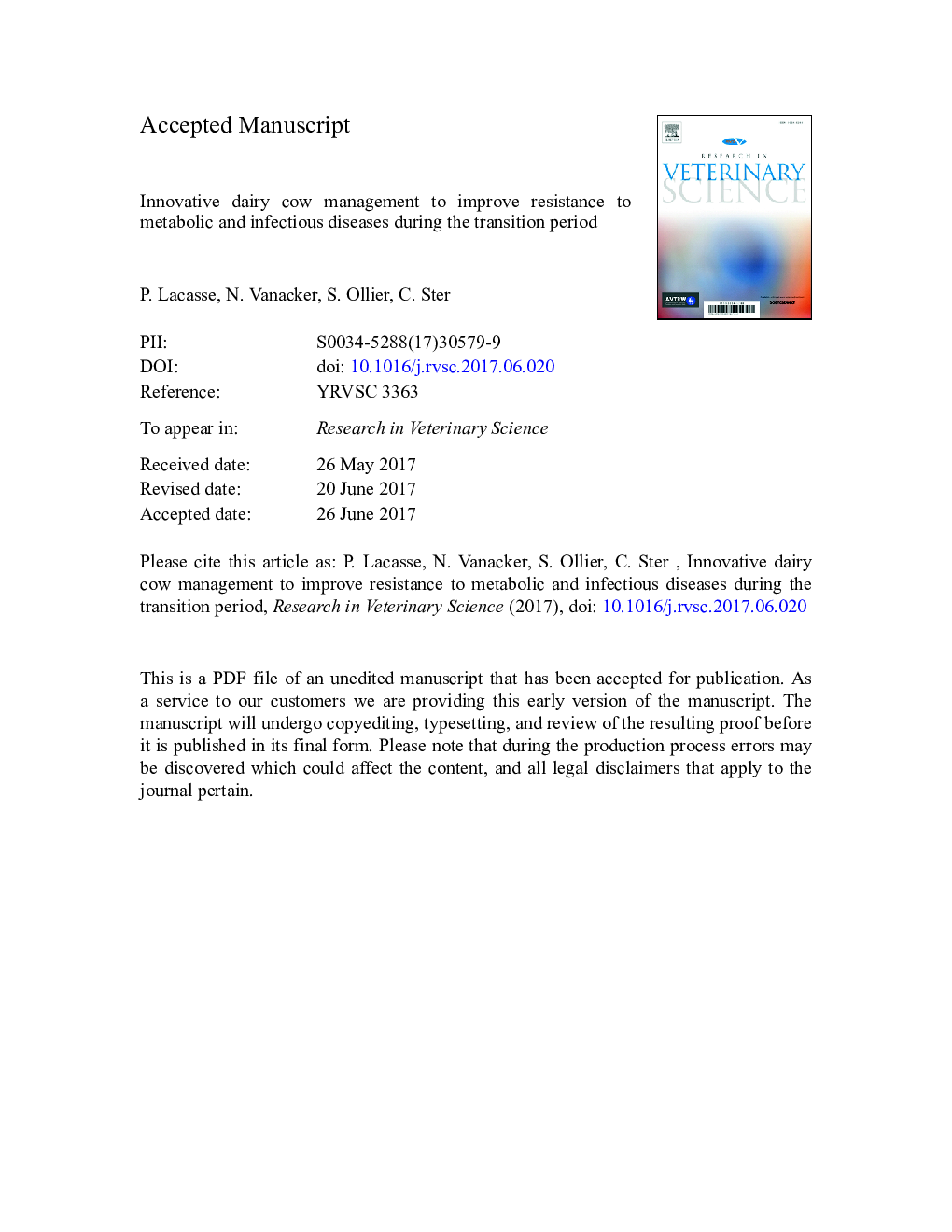| کد مقاله | کد نشریه | سال انتشار | مقاله انگلیسی | نسخه تمام متن |
|---|---|---|---|---|
| 8504053 | 1554295 | 2018 | 34 صفحه PDF | دانلود رایگان |
عنوان انگلیسی مقاله ISI
Innovative dairy cow management to improve resistance to metabolic and infectious diseases during the transition period
ترجمه فارسی عنوان
مدیریت گاو نوآورانه برای بهبود مقاومت در برابر بیماری های متابولیکی و عفونی در طول دوره گذار
دانلود مقاله + سفارش ترجمه
دانلود مقاله ISI انگلیسی
رایگان برای ایرانیان
کلمات کلیدی
پاسخ ایمنی، مدیریت شیردوشی، دوره گذار، مرور،
ترجمه چکیده
شیوع بیماری های متابولیکی و عفونی در طول دوره شیردهی بسیار متفاوت است. موارد جدیدی از ماستیت بالینی در ابتدای شیردهی ظاهر می شود و میزان شیوع آن با میزان تولید شیر افزایش می یابد. علاوه بر ماستیت، بسیاری از بیماری های عفونی دیگر در طی 2 هفته اول شیردهی به طور بالینی دیده می شوند. در طی این زمان، گاوها در تعادل انرژی منفی قرار دارند و باید ذخایر بدن را بسیج کنند تا تعادل بین مصرف انرژی انرژی و انرژی مورد نیاز برای تولید شیر تولید شود. ارتباط بین کمبود انرژی و بیماری های متابولیکی مانند کتوز و لیپیدوز کبدی، به خوبی شناخته شده است. علاوه بر این، گاوها در کمبود انرژی دارای سیستم ایمنی ضعیف هستند و بنابراین بیشتر به عفونت ها حساس هستند. در حال حاضر شواهد خوبی وجود دارد که افزایش در گردش اسید های غیر استرادیلی باعث کاهش عملکرد سلول های ایمنی بدن می شود. بنابراین، رویکردهای مدیریتی که موجب کاهش تعادل انرژی منفی و افزایش اسید های غیر استرادیده در ابتدای شیردهی می شوند، احتمال افزایش مقاومت در برابر عفونت را دارند. بهبود تامین مواد مغذی از طریق مدیریت تغذیه در دوران کودکی، موضوع تحقیق قابل توجه بوده است. با این حال، راه دیگری برای کاهش عدم تعادل بین عرضه و تقاضای مواد مغذی، موقتا کاهش آن است. در این بررسی، ما بررسی می کنیم که چگونه استراتژی های مدیریتی از قبیل تغذیه اسید لینولئیک، شیردهی قبل از زایمان یا محدود کردن تولید شیر شیر پس از زایمان میتواند برای کاهش اختلالات متابولیکی و سرکوب ایمنی در طی دوره گذار استفاده شود. در این مرحله، به نظر می رسد که کاهش میزان شیر پس از زایمان با استفاده از شیردهی جزئی در روزهای اول پس از زایمان، روشی امیدبخش برای کاهش استرس متابولیک و سوء پیشگیری از سیستم ایمنی است بدون اینکه از بهره وری بالا گاوهای شیری بهره مند شود.
موضوعات مرتبط
علوم زیستی و بیوفناوری
علوم کشاورزی و بیولوژیک
علوم دامی و جانورشناسی
چکیده انگلیسی
The incidence of metabolic and infectious diseases varies greatly during the lactation cycle. Most new cases of clinical mastitis appear at the beginning of lactation, and the incidence increases with the level of milk production. In addition to mastitis, many other infectious diseases become clinically apparent during the first 2Â weeks of lactation. During this time, cows are in a negative energy balance and must mobilize body reserves to balance the deficit between food energy intake and energy required for milk production. The relationships between energy deficit and metabolic diseases, such as ketosis and hepatic lipidosis, are well known. Furthermore, cows in energy deficit have a weakened immune system and are therefore more susceptible to infections. There is now good evidence that the increase in circulating non-esterified fatty acids impairs immune cell functions. Therefore, management approaches that reduce the negative energy balance and the increase in non-esterified fatty acids at the beginning of lactation are likely to improve resistance to infection. Improving the nutrient supply through periparturient nutritional management has been the subject of considerable research. However, another way to reduce the imbalance between nutrient supply and demand is to temporarily decrease the latter. In this review, we examine how management strategies such as conjugated linoleic acid feeding, prepartum milking, or limiting postpartum milk production could be used to reduce metabolic perturbations and immunosuppression during the transition period. At this stage, it appears that reducing the amount of milk harvested postpartum by means of partial milking in the first days after calving is the most promising approach to reduce metabolic stress and immunosuppression without compromising the productivity of high-yielding dairy cows.
ناشر
Database: Elsevier - ScienceDirect (ساینس دایرکت)
Journal: Research in Veterinary Science - Volume 116, February 2018, Pages 40-46
Journal: Research in Veterinary Science - Volume 116, February 2018, Pages 40-46
نویسندگان
P. Lacasse, N. Vanacker, S. Ollier, C. Ster,
